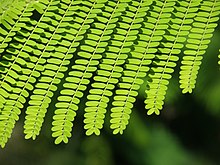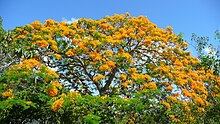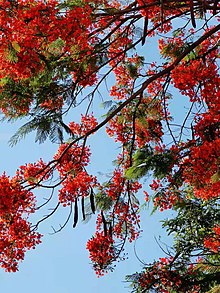Delonix regia
Madagascar framboyan (Delonix regia), is a tree of the Fabaceae family. It is one of the most colorful trees in the world due to its red, orange flowers, and its bright green foliage. It can measure up to 12 m. In Tropical America it is considered an exotic ornamental species, which is why it has a wide distribution. Its natural habitat is dry deciduous forests. Its use by humans is broad and depends on the culture of the country in which it is located.
Description









This tree reaches an average height of about 8 meters, although it can reach 12 or 15 m. Its foliage is dense and widespread, in areas with very marked dry seasons it loses its leaves, however, in less rigorous conditions it is evergreen.
The flowers are large, with four petals up to 8 cm long and a fifth petal called the banner, which is longer and spotted with yellow and white; A natural variety of Delonix regia called flavida has yellow flowers. The mature pods are woody, dark brown, 60 cm long and 5 cm wide. The seeds are small and weigh about 0.4 g. The leaves are 30 to 50 cm long, each has 20 to 40 pairs of compound primary leaflets, also called pinnate, and each of these is in turn divided into 10 to 20 pairs of secondary leaflets.
Distribution and habitat
It is native to the dry deciduous forest of Madagascar, where it is in danger of extinction. However, their cultivated and naturalized counterparts extend throughout various parts of the world: In the United States it grows only in Florida, the Virgin Islands, Hawaii and southern Texas. It also occurs in Puerto Rico, Mexico, Central America, Cuba, the Dominican Republic and the rest of the Caribbean; as well as in Venezuela, Colombia, Ecuador, the coastal area of Peru, eastern Bolivia, Paraguay, Brazil, the northeast coast and subtropical jungles of Northwest Argentina and India and it has been naturalized in many places in Australia. And especially in African countries, very common in the Cape Verde Islands, a country very similar in climate to the Canary Islands, where it is also common in the Canary Islands (Gran Canaria, Lanzarote, Fuerteventura, La Graciosa, Tenerife, La Palma, La Gomera and El Hierro) and Madeira. In mainland Spain, there are specimens located in the city of Cádiz and on the Valencian and Alicante coasts (frost-free climates). It is considered an invasive species because its dense and broad shade prevents the growth of other plant species around it. It requires a tropical or tropical-like climate to survive, although it can tolerate drought and salinity.
In Mexico, being an exotic species, it is distributed practically throughout the national territory with the exception of Baja California and the central northern part of the country.
Uses
The Caribbean natives use the ripe pods and seeds as percussion instruments known as shak-shak or maracas.
They are also used as livestock feed in some places in Colombia. In addition to its ornamental use in streets and public spaces, it is used as a shade tree because its foliage spreads widely.
Basque immigrants introduced it to Argentina where it is known as chivato and in the Basque Country, its branches are used to fence goats and that is why these branches are called "chivatas".
Properties
In Puebla, Veracruz and Baja California Sur the bark is applied macerated on the joints, when people suffer from rheumatism. In Michoacán, the decoction of the flowers administered orally is used for respiratory problems such as cough and bronchial asthma.
- Chemistry
The flowers of Delonix regia contain the flavonoids, kaempferol, 3-0-beta-genobioside, cyanidin 3-0-beta-glucoside and quercetin, the latter also present in the seed. The triterpene, lupeol, and the sterol beta-sitosterol have been identified in the bark of the trunk.
Common names
- flamboyan
- Chivato
- flamboyant
- Tabachín tree
- malinche
- actual
- Acacia (in Colombia, Panama and Venezuela)
- Clavellino de Madagascar
- Framboyán de Madagascar
- Malinche de Madagascar
- Tree of fire
- Tabachín, Mexico
Conservation status
In Mexico it is considered an exotic species.
Taxonomy
Delonix regia was described by (Bojer ex Hook.) Raf. and published in Flora Telluriana 2: 92. 1836[1837].
- Etymology
Delonix: generic name that comes from the Greek words: δηλος (delos), which means "evident", and ονυξ (onyx), which means "claw", referring to the petals
regia: Latin epithet that means "regia, royal"
- Sinonimia
- Poinciana regia Hook.
- Poinciana regia Bojer
Common names
In the Spanish language it has several names:
| Name | region |
|---|---|
| acacia | Venezuela |
| red acacia | Colombia |
| red acacia | Honduras |
| tree of fire, flower of fire | Guatemala |
| tree of fire | El Salvador |
| shade tree | Mexico (northwest region) |
| Chivato | Argentina (where used in urban public spaces) |
| Chivato | Paraguay (where used in urban public spaces) |
| flamboyan | Canary Islands |
| flamboyan | Cuba |
| flamboyan | Puerto Rico |
| flamboyan | Dominican Republic |
| flamboyan | Mexico (Southeast region) |
| flamboyan | Venezuela |
| flamboyant | original name in French |
| framboyán | Cuba, Mexico (in the city of Veracruz) |
| Pussy. | Venezuela (in the state of Anzoátegui) |
| josefino | Venezuela (in the Barinas state) |
| malinche | Costa Rica |
| malinche | Nicaragua |
| Poinciana regia | according to Bojer |
| Poinciana regia | according to Hook |
| Ponciana | Peru |
| Flamboyan | |
| actual | |
| tabachín | Mexico (central-occurring region) |
| tabatin |
Contenido relacionado
Dendrochloa distans
Hickelia
Deschampsia
Catha edulis
Allium